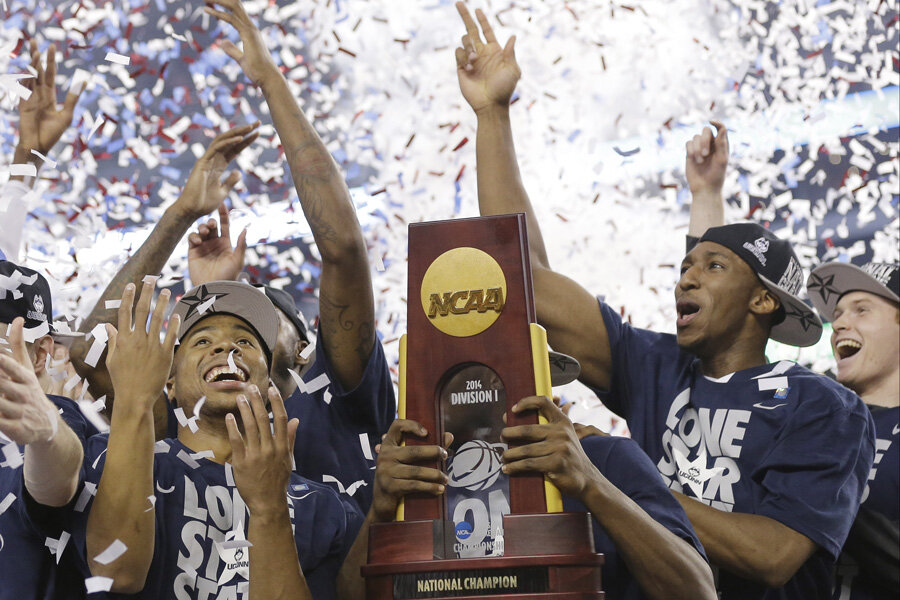UConn NCAA national champs: How the Huskies beat Kentucky's freshmen phenoms
Loading...
Aside from an unflinching belief in themselves, the University of Connecticut Huskies relied on their own patented pressure defense, as well as old-school fundamentals, to defeat a persistent and athletically-adept Kentucky Wildcats team, 60-54, Monday night to win the 2014 NCAA men’s basketball championship at AT&T Stadium in Arlington, Texas.
Right from the start, the Huskies were led by senior guard Shabazz Napier, winner of the Final Four's Most Outstanding Player award, who could regularly be seen coaching or encouraging his teammates. Once, when the Huskies had the ball, he actually shoved fellow guard Ryan Boatright back toward mid-court, as he was presumably running the incorrect route on the play. It was evidence of the focus Napier has found in the latter part of this season, which UConn coach Kevin Ollie tapped into throughout the tournament to unite the team.
Connecticut, who never trailed in this game, got off to a strong start in the first half, building up a lead of 15 points before Kentucky coach John Calipari shifted defensive gears, deploying an infrequently-used 2-3 zone which cooled off the Huskies’ offensive thrust and got the Wildcats within four points at halftime, 35-31.
Though the second half was an offensive nightmare for UConn - with 1:49 left in the game, they had shot a dismal 8-23 from the floor but had extended their lead - it was even worse for Kentucky; particularly shooting free throws, where despite getting to the line 24 times, the Wildcats only made 13 (54%). But the Huskies managed to hit all ten of their attempts, which made up for their lackluster shooting. It helped make up for the noticeably poor performance by strong forward DeAndre Daniels, who only hit four of 14 field goals for 8 points on the night.
And as for Kentucky’s backcourt tandem of brothers Andrew and Aaron Harrison, they were harassed all night by UConn counterparts Napier and Boatright, who held them to a combined 15 points and only five assists. UConn’s two guards also combined for six steals that repeatedly halted Wildcat scoring drives. Napier and Boatright (who fought through an ankle injury in the second half) combined for 36 combined points, and were joined in double figures by a third guard, Niels Giffey, who hit for 10 points, with two key three-pointers, while grabbing five boards.
Kentucky was led in scoring by guard James Young, who had 20 points to go with seven rebounds. And his teammate, strong forward Julius Randle, added 10 to go with 6 rebounds. But they were the only Wildcats who reached double figures on the night. With notable exceptions, Kentucky’s perimeter game was completely demoralized. With every UConn free throw that went in during the final two minutes, their scoring was largely unanswered at the Wildcats’ end of the floor. It got to the point where, as Calipari later remarked, Kentucky didn’t foul at the end, because “… they [UConn] were making everything.”
In holding UConn to only 25 points in the second half, Kentucky did a wonderful job of short-circuiting the Huskies’ transition game, which wreaked havoc on Michigan State in UConn's East region final a week ago Sunday. But the real nagging question was why the Wildcats inexplicably abandoned the zone defense in the second half. Calipari had reportedly not had daily practices of the zone with his team of freshmen until earlier this year. But once it went into action Monday night, it was dramatically effective, causing the Huskies to go scoreless for over three minutes between Napier baskets, and enabling the Wildcats to mount a 16-5 run of their own that got them close at halftime―this against a UConn squad that had been +22 in points in the paint over their previous two games.
UConn’s national title comes in the wake of last year’s NCAA sanctions for poor grades, which made them ineligible for post-season play. But it only seemed to make this season even sweeter for the seventh-seeded Huskies, whose senior star Napier now has “bookends” for NCAA titles (he also won in 2011 as a freshman). UConn is now the lowest seed to win a national championship since Rollie Massimino’s Villanova Wildcats won it in 1985 as an eight seed. And it’s quite possibly the first victory any college squad has had in the presence of two former US presidents - Bill Clinton and George W. Bush - observing the action as guests of Dallas Cowboys owner Jerry Jones.







